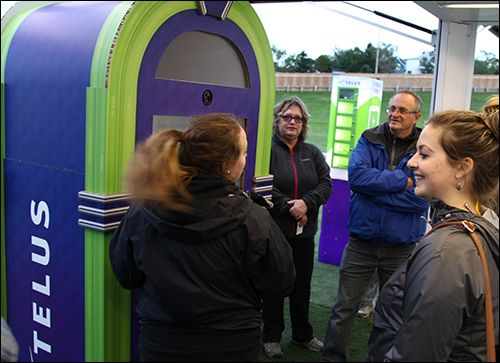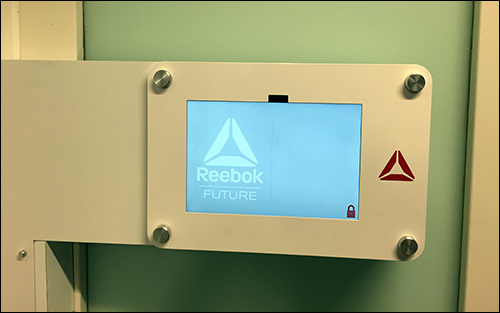Athletic footwear and apparel company Reebok is using an RFID-based solution provided by a Montreal digital signage company called iGotcha Media to display product information to visitors at its Innovation Showroom. Canadian music festival Grand Fetes Telus is also employing iGotcha’s RFID-based solution, to provide concert goers with automatic access to venues, and to take pictures, share information with social-media networks and participate in contests.
IGotcha launched a decade ago to provide interactive content to consumers at cafés and other businesses, via tablets and digital signage. The company offers software for the digital signage it provides, along with wayfinding software, apps and event marketing with interactive displays.

“We’re a software company at our core,” says Kyle Pilot, iGotcha Media’s technology VP. “We offer an experience that pulls data from new technologies.” That includes facial recognition, radio frequency identification and other types of sensors, he adds.
Recently, the firm has been offering Near Field Communication (NFC) RFID functionality to link individuals with their location or product of interest, thereby prompting a response on the signage. It began working with Reebok several years ago, Pilot says. At Reebok’s Innovation Showroom, located at its headquarters in Canton, Mass., retailers can view Reebok’s latest product offerings and learn more about the company, its manufacturing facilities and the products themselves. In October 2015, IGotcha provided Reebok with a solution that included large video screens mounted on three of the room’s four walls, for displaying content regarding the company and its products. With RFID, iGotcha has enabled Reebok to offer more than that, however—it can also ensure that the content is displayed at the appropriate times and about the correct product.
“RFID was used in the innovation room to explain future concepts that Reebok is working on,” says Bill McInnis, Reebok Future’s VP. “RFID allowed us to ‘play’ the room, using shoes or objects to advance the storytelling in a seamless way.”
First, a presenter brings a tour group to the room. That individual has an RFID tag with an NXP Semiconductors NTAG213 13.56 MHz NFC chip attached to a watch, or a tablet he or she is carrying. A door lock with a built-in Advanced Card Systems (ACS) ACR122U reader is located at the door. The presenter taps his tag against the reader, which captures the unique ID number of that tag. The software confirms that the tag is linked to an authorized individual and unlocks the door.
The presenter and tour group then enter the room. Once inside, the presenter can tap his tag against another ACR122U reader, in order to turn on the room’s lighting. This can also cause video and images to be displayed on the screens, and music to begin playing.
Within the room are four RFID-enabled stations for displaying products. Several dozen shoes and other Reebok products have NTAG213 tags attached to them. The presenter or a member of the tour group can pick up a product and place it on one of four podiums, each of which has a built-in ACR122U reader with a USB connection to a computer running the iGotcha software. The device captures the product’s tag ID and prompts the software to display videos and information about that item on the wall-mounted screens.

“There were many comments that the room felt more like a guided tour of where we’re going, versus a typical presentation,” McInnis recalls. “A lot of that was due to the RFID.”
Since the system was taken live in November, Reebok has used the technology to capture the interest of potential customers who visit its headquarters and Innovation Showroom. Reebok is now working with iGotcha to add RFID to a mobile innovation room that will be set up at a trade show hosted by Reebok.
Grand Fetes Telus, which takes place in Parc Beauséjour (about 200 miles northeast of Quebec City), plans to use iGotcha’s RFID-based solution for this year’s festival, which will take place on July 20-24, for what will be the second year in which ticket holders will be linked with access control and other features via NFC. The festival sells its tickets at a variety of retail points throughout Quebec, as well as at its gates on the day of the festival. Altogether, approximately 18,000 people buy tickets for the show.
Each ticket has an NTAG213 chip encoded with a unique ID number. When an individual buys a ticket, she can use her smartphone or other NFC-enabled device to access the festival’s URL and register. (If she does not have an NFC-enabled device, she can input the ID number printed on the front of the ticket.) The customer then enters information about herself, including her name, e-mail address, date of birth, and eye and hair color. This data is stored in iGotcha’s software on the festival’s server.
On the day of the show, the ticket holder arrives at one of several entry points, at each of which employees are stationed with Google Nexus 9 tablets with a built-in NFC RFID reader. The workers use the tablet to read each ticket’s ID number, view the individual’s information and confirm that he or she is authorized to enter. The attendee’s hair and eye color, as well as date of birth, can be used to confirm that the individual presenting that ticket is the correct ticket holder. The iGotcha software also stores the transaction data so that the system knows who has entered. When that person leaves the venue, the ticket is read again, so that the system will permit that visitor to re-enter with the same ticket if he or she chooses to do so.
The iGotcha software also knows who is authorized to enter VIP areas. Staff members stationed at those entrances can utilize NFC-enabled tablets to confirm each ticket holder’s identity before that person enters any such area.
Additionally, the system allows for other activities, such as linking visitors to their Facebook friends. Attendees can use the tickets at a photo booth to take pictures and share them on their Facebook wall. Users can simply tap their tickets against the ACR122U readers built into the kiosks, then follow prompts on the touchscreen to share those pictures, as well as like bands on social media or enter contests.
For the venue, the data from the system allows organizers to determine, in real time, how many people are entering particular areas. What’s more, they can identify if any congestion might be occurring—at the entrance, for example.
Last year, the venue included six or so RFID-enabled entrances, Pilot says, as well as about the same number of RFID-enabled kiosks for photos, social-media networks and contests. This year, Pilot says, the festival is working with iGotcha to set up the system in a similar manner, though the details have yet to be determined.

